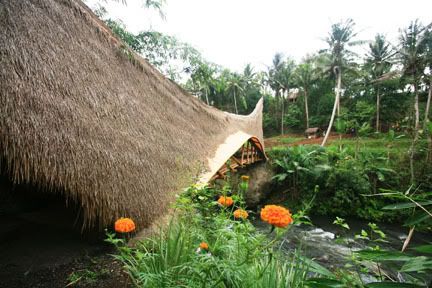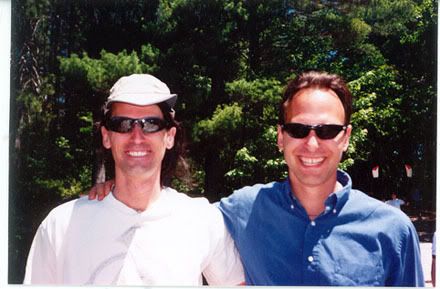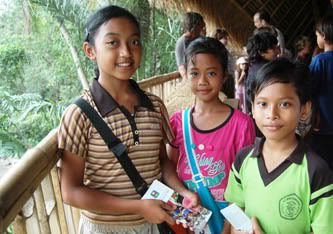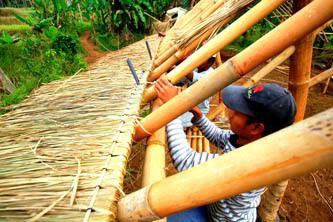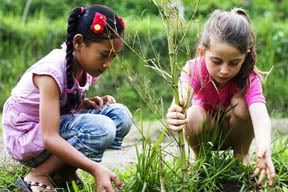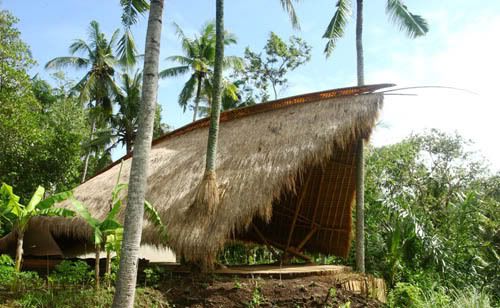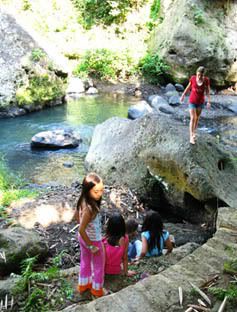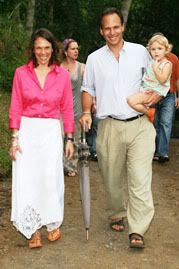Brad Choyt, Director of John and Cynthia Hardy’s Green School in Bali, Indonesia
Introducción:
John Hardy Jewelry has always been deeply rooted in environmental responsibility as well as an abiding love of Bali. Last year, John and Cynthia sold the company and immediately started a visionary international school, called Green School, located between Ubud and Denpassar in Bali. My brother, Brad Choyt, was hired as Green School’s Director.
Since last August, Brad has been busy implementing the “green” vision, from hiring faculty and developing curriculum to advising on the design and uses of bamboo buildings. I visited him, his wife, the novelist, Charlotte Bacon, and my nephew and niece in March, 2008.
I stayed on campus in his open-air bamboo house above the beautiful Ayung River Valley. Our conversations were punctuated with “GEKO…. GEKO… GEKO” lizard calls from the ceiling.
De hecho, there are three Geckos in residence: Egor, who is the largest; Sling, who is the fastest and slightly smaller than Egor; and Mick, who has very large lips. I enjoyed the composting toilets and even made friends with the dark black snake on the bathroom floor that greeted me several times in the middle of the night. Balinese gamelon music echoed through the jungle.
The School is slated to open in September, 2008 and it is now taking applications for student enrollment. On-line applications are available at: www.greenschool.org
FJ: Primero, can you please briefly explain just a few basic facts about the School and campus? How big is the school going to be and who is going to attend?
BC: The School will have 80-100 students in its first year, including preschool and kindergarten through Year 8. Each class of 16-18 students will have three faculty: a master western-trained teacher, a master Indonesian teacher, and a participant in our New Teacher Program who is a recent college or university graduate beginning a career in education. We expect students to come from all over the world, but we have reserved 15-20% of the spaces for Indonesian students on financial aid who would not ordinarily have access to quality education. We will be one of the very few international schools in SE Asia that has such a large of a percentage of students from the local community.
FJ: How is the hiring and building proceeding?
BC: From the very beginning, we have put a lot of energy into developing an excellent website and this has greatly helped with attracting talented faculty from all over the world. To date, a majority of the teachers have been identified, including nearly all of the western master teachers. The School has attracted a very talented group of professionals. On average, the western teachers have close to 20 years of experience in the classroom, that he or she will bring to Bali. So although we are a new school, our teachers will be very knowledgeable in the field of education.
Several buildings and structures around the campus are complete, including a beautiful bamboo bridge that crosses the Ayung River. Classrooms are scheduled to be finished by the end of this month. Photos of the architecture and other images from our School can be found at http://www.greenschool.org/gallery
FJ: Hasn’t it been difficult to get applicants to a school that hasn’t even started?
BC: The fact that our doors are not yet open has posed an additional challenge and we set the bar high: an enrollment of 80 students in our first year. Sin embargo, when people take the time to read about our curriculum, learn about the faculty that we have hired, or visit the incredible eight-hectare campus, they understand that the School will be truly special and they get excited about becoming a member of our community from day one. A consecuencia, several of our classes are now approaching full enrollment and we anticipate having a waiting list for new students within the next month.
FJ: I know that the school has garnered a lot of international attention. When I was there, Thomas Freedmen visited and endorsed your project. Can you please highlight what makes this project so exceptional and radical?
BC: In many ways, what we are trying to create is a model for what education can and should be in the 21st century. This includes having a curriculum focused on multiple intelligence theory, having small classes with low student to teacher ratios, and having an inspirational learning environment where students can work together to present perspectives and collaborate in solving complex problems. Thomas Friedman was, por supuesto,, interested in these ideas as well. But his next work is also centered on the environmental issues so Green School has a special appeal.
As an educator, I am confident that schools can either be part of the problem or part of the solution. What we are building here in Bali will be a learning environment where students grow to respect and value their natural surroundings. The School’s curriculum will, por supuesto,, include the basics such as reading, writing, math, and science. But these lessons will often take place outside of the classroom walls, providing students with the chance to closely observe plants and animals and make connections between what they are learning, who they are, and the natural world.
FJ: What have been some of the most challenging, unexpected elements in the development of the vision of the school?
BC: In many ways, we are part school, part laboratory. And as such, we know that our experiments won’t always work. But when we are able to build truly unique buildings from bamboo, when we are able to find a new material that is eco-friendly and provides a greener alternative to other materials that have a negative impact on the environment, when we are able to develop new methods of composting or generating alternative forms or energy, then the discoveries more than compensate for the extra time and effort needed to think outside of the box. Our founder, John Hardy, likes to say that we are “copy left” as opposed to “copy right”. And once we find alternative ways of doing this kind of work, we are happy to share them with others who are also concerned about the environment and the education of the next generation of world leaders.
FJ: What have you learned in the process of moving your family from Brooklyn to Bali? Surely there’s been some culture shock?
BC: It has been quite a shock in many ways, but probably more for my wife and kids than for me since I lived in Nepal and India for several years in the 1980’s. Of the hundreds of things I could mention here, these are two that rise to the surface: 1) Kids are very adaptable. My eight-year-old son and my almost-two-year-old daughter have made a particularly easy transition, due largely to the kindness and generosity of the Balinese people. And I am delighted to offer them the perspective of growing up in a developing nation that has many beautiful and rich traditions. And 2) Despite all of the differences between living in New York and living in Bali, it is obvious that people generally want the same things: safe places to live; support from their communities; opportunities to make a livelihood; good schools for their children; etc. Taken from this perspective, there is a great deal each location shares in common and of course each place provides valuable perspectives from which you can learn.
FJ: Is there anything else that you would like to add that you feel it is important for my readers to know?
BC: Only this: what we are doing in Bali, in many ways, is very radical. Building a school with environmental ideals out of bamboo is not something that I would have ever imagined doing in my lifetime. Sin embargo, in another light, it also is the only solution that I can envision for making the world a better, greener place. I believe that deep, meaningful change has to start with learning that will cultivate a respect for the environment and give students the tools they will need to become stewards of the natural world. I hope that we can do this here at Green School and that these ideas will catch and grow well beyond Indonesia. We are now looking for others who share this perspective and want to join our community as parents, students, amigos, and supporters. Come see our school in Bali for yourself. I guarantee that you will find that something truly inspirational is in the works.
FJ: Thank you. More information about Green School can be found on their website: www.GreenSchool.org

